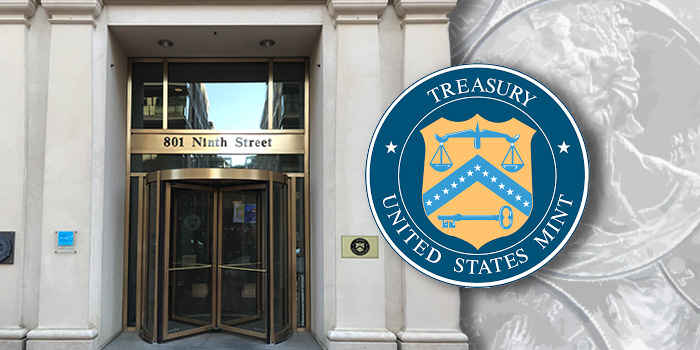
By Charles Morgan and Hubert Walker for CoinWeek …..
On October 16, 2017, the United States Mint convened a second gathering of numismatic industry stakeholders in order to share information and ideas to reinvigorate the hobby. Titled “The Road Ahead”, the forum was the centerpiece of the Mint’s efforts to foster a dialogue. The day-long forum was held at Mint Headquarters on 9th Street in Washington, D.C.
Jovita Carranza, the 44th Treasurer of the United States, and David Motl, the Acting Deputy Director of the United States Mint, kicked off the event with their opening remarks. Motl, who replaced Rhett Jeppson earlier this year, is serving as head of the Mint until either a new Director takes control or Motl is otherwise replaced. Which could happen soon; on October 3, President Donald J. Trump nominated David J. Ryder for Director of the Mint. If approved by the Senate, it will be a return engagement for Ryder, who served as U.S. Mint Director from 1992 to 1993 under President George H. W. Bush.
As far as we could tell, both Carranza and Motl made a good impression on the attendees.
Further representatives of the Mint (and there were many present) included project managers and key department heads. Representing the coin industry were leading wholesale dealers and online e-retailers, along with the two major grading services, American Numismatic Association (ANA) President Gary Adkins, several members of the Citizens Coinage Advisory Committee (CCAC), and the leading hobby publications.
The Implementation of Previous Forum Ideas
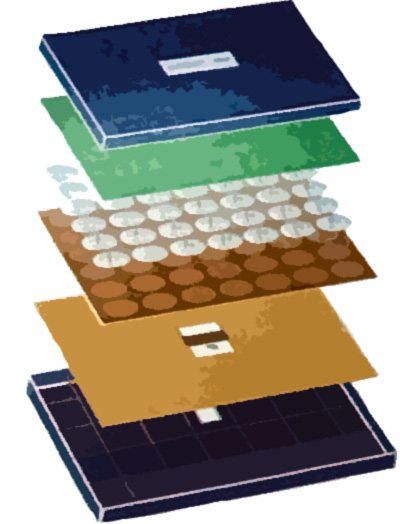 Last year’s forum, held in Philadelphia at the Federal Reserve Bank, yielded some good feedback for the Mint, which led to a few experiments this year. These included a “bulk pack” pilot program for Proof Silver Eagles, changing household order limits, and the scheduling of more releases ahead of time to help dealers make better purchasing decisions. The Mint discussed the results of these experiments at this year’s forum, along with their plans for future implementation and refinement.
Last year’s forum, held in Philadelphia at the Federal Reserve Bank, yielded some good feedback for the Mint, which led to a few experiments this year. These included a “bulk pack” pilot program for Proof Silver Eagles, changing household order limits, and the scheduling of more releases ahead of time to help dealers make better purchasing decisions. The Mint discussed the results of these experiments at this year’s forum, along with their plans for future implementation and refinement.
Bulk Packaging
In 2016, PCGS spearheaded the discussion on bulk packaging and impressed upon the Mint the benefit of providing wholesale buyers the option to buy numismatic products in volume without being burdened by the cost of shipping and disposing of government packaging (like the typical clamshell box) for each individual piece. It would also allow for faster turnaround time between a dealer’s purchase and the return of coins submitted to third-party services for grading.
As part of its 2017 pilot program, the U.S. Mint tested a bulk pack housing five trays of 42 coins per tray for the 2017-W Silver Eagle Proof coin. The bulk pack had a 99.5% sell-through rate and was met with a favorable response, generating $2.6 million in revenue with a 4% discount price for dealers.
Robert Fickling, the Mint’s new Bulk Manager, offered a multi-phase plan that included more analysis and tooling for the bulk pack. 2018 will see a continuation of the program, with new products currently being available only in 2019 and beyond. There may be important reasons for the cautious Mint rollout, but it was clearly the desire of dealers in attendance that it move faster. PCGS again pushed for a speeding up of this process and increased integration of the bulk pack option with multiple numismatic product lines.
Numismatic Medals
Medals have traditionally lagged behind coin products, but several recent issues struck in silver have been successful. This increasing interest in medals is due, in large part, to the fact that the Mint is allowed some flexibility when it comes to its gold bullion coin program. The Mint has found that popular gold bullion coin designs can translate into popular silver medal programs, thereby opening up the market to more buyers.
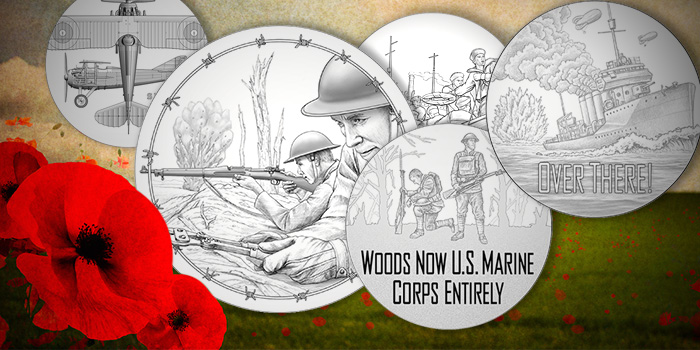
The success of the 2016 American Liberty silver medal took the Mint by surprise, so it asked attendees at the first forum how it could expand upon this. Hobby representatives suggested limited editions and dated pieces. Consequently, 2017 saw the production of limited-mintage silver medals to mirror the 225th Anniversary gold coin, and next year will feature the release of five distinct silver medals to accompany the release of the World War I Veterans Centennial commemorative silver dollar.
Promoting the Hobby
Further discussions in 2016 centered on the Mint’s role in promoting the coin hobby.
The Mint’s marketing strategies are problematic for the rare coin industry for a number of reasons, not the least of which is that the Mint does not support financially any numismatic publications – all of which invest tremendous amounts of time and resources in providing what amounts to free advertising for the Mint’s products. The Mint also does not have an apparent budget for hosting industry VIPs at major coin releases or coin striking ceremonies.
This may seem self-promoting coming from a publication that would benefit from such an outlay, but we believe that other industries prove the point easily. When an industry engages directly with the community and media that supports it, then better and more exciting content about the market and its products is made. Just look at the video game industry, consumer electronics, the automobile industry, etc., etc.
 Another recommendation that we specifically made to the Mint in 2016 was that it would benefit from establishing itself as a lifestyle brand, making products with a focus on detail – from the coin itself to its packaging. Unlike the bulk packaging issue discussed above, the United States Mint has long been losing ground to other world mints on retail packaging. The Mint listened to this recommendation and is working to implement better packaging for its gift products. The packaging that the Mint developed for the 225th Gold Coin and Silver Medal programs were perfect.
Another recommendation that we specifically made to the Mint in 2016 was that it would benefit from establishing itself as a lifestyle brand, making products with a focus on detail – from the coin itself to its packaging. Unlike the bulk packaging issue discussed above, the United States Mint has long been losing ground to other world mints on retail packaging. The Mint listened to this recommendation and is working to implement better packaging for its gift products. The packaging that the Mint developed for the 225th Gold Coin and Silver Medal programs were perfect.
The Mint also is working on coin programs geared toward children for the 2019 calendar year. These programs will launch and be supported by original characters developed exclusively for the Mint. The program is meant to target seven- to 12-year-old children and will include sets and a standalone concept. Focus group testing will begin in 2018.
As for general takeaways from the 2016 forum, the Mint stated that three main issues stood out: the need to acquire new customers for the hobby, the need to stem the tide of diminishing core product sales (mint sets, proof sets, etc.), and to promote gift giving. Last year’s participants shared many specific ideas–some of them quite exciting–for new Mint products and marketing tactics, but it is not unfair to say that these three points were recurring themes.
You can read our very thorough report on the 2016 forum for more details.
2018 Product Schedule
The United States Mint provided attendees at the 2017 forum with a five-page outline of its 2018 product schedule, divided by season.
The key numismatic products for 2018 include the World War I Centennial Silver $1 coin program, the Preamble to the Declaration of Independence Platinum $100 coin, the Breast Cancer Awareness Gold $5, Silver $1 and Clad 50¢ coin program, and the just-announced 50th Anniversary of San Francisco Proof Sets Reverse Silver Proof Set.
The World War I Centennial Silver Dollar program will be the first of two commemorative coin programs released in 2018.
Production of the coin is authorized by the World War I American Veterans Centennial Commemorative Coin Act (Public Law 113-212), signed into law by President Barack Obama on December 16, 2014. The Act calls for the production of not more than 350,000 .900 fine silver Proof coins.
In addition to the coins, the U.S. Mint received approval from the Treasury to produce up to 100,000 silver Armed Service Medals using .900 fine silver coin blanks. These medals will be struck in a Proof finish and will be bundled individually with the World War I dollar. This means that collectors who wish to collect a complete set of five service medals will have to purchase five World War I coins.
When questioned about this policy and why the Mint did not also produce a five-medal set, Ann Bailey, Branch Chief in charge of Product Management, said that the purpose of the medal program was to help sell the $1 coins. It is our opinion that a seven-piece set, including one Proof and one Uncirculated World War I coin, would be a reasonable compromise, but no such product is in the works. Additionally, the 100,000 medal mintage limit applies to the total sales for all of the medals combined – which has the potential to create an interesting secondary market for the less popular medals. We predict that the medal program will sell out immediately.
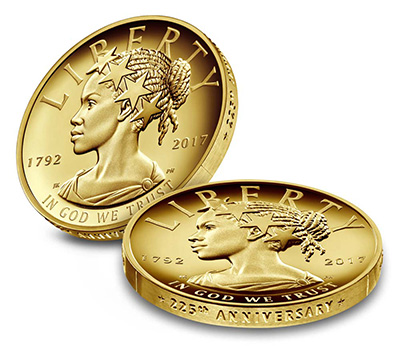 The 2017 225th Anniversary Gold Coin will make a return in 2018 with a 1/10th ounce version, to be released early in the year. The fractional denomination will be struck in lower relief and lack the dual date 1792-2017, featuring only the date 2018 instead. A follow-up $100 gold bullion coin was not discussed.
The 2017 225th Anniversary Gold Coin will make a return in 2018 with a 1/10th ounce version, to be released early in the year. The fractional denomination will be struck in lower relief and lack the dual date 1792-2017, featuring only the date 2018 instead. A follow-up $100 gold bullion coin was not discussed.
The second commemorative coin program of 2018 seeks to increase breast cancer awareness.
The program was authorized by Public Law 114-148, the Breast Cancer Awareness Commemorative Coin Act, which was signed into law on April 29, 2016. The act calls for the production of up to 50,000 $5 gold coins made in a “pink gold” alloy made up of not less than 75% gold; up to 400,000 $1 silver coins in the traditional .900 fine, 11.34 grams, 1.5″ format; and not more than 750,000 copper-nickel clad half dollar coins. Designs are expected to be announced on October 23.
The Mint is showing seven product offerings related to this program. The first six products are individual offerings of each coin in Proof and Uncirculated finishes, which will go on sale in the Spring. In the Fall a clad half-dollar and postage stamp set will also be offered.
In the Summer, the Mint will honor the 50th anniversary of the San Francisco Mint striking Proof sets with a special silver Reverse Proof Set. The Reverse Proof Set will be released in addition to the standard Silver Proof Set, which is slated for a fall release.
For more information on the product offerings that lie ahead for Winter 2018 (January to the end of March), please read this report.
New on the Agenda
Unlike the 2016 forum, which broke into working groups and had a more collaborative, “fact-finding” feel, the 2017 iteration had a didactic feel to it. The Mint’s program was geared towards educating stakeholders about the way the Mint operates and what its limitations are.
The titles of the presentations: “Legislative Affairs – Their Impact on United States Coin and Medal Development”, “Design Management: Artwork, Design Competitions and the Approval Process”, and “E-Commerce and Marketing Review” are illustrative of the Mint’s aims in this second get-together. While the Mint was open to suggestions and feedback and was absolutely professional in its demeanor, it was clear to us that the Mint was in control of the conversation.
Ron Harrigal, Manager of Design and Engraving, led a discussion on the development of pink gold and palladium coins. We learned from Harrigal’s presentation that the final alloy composition selected for the Breast Cancer Awareness $5 coin is a composition of 85% gold, 14.8% copper, and 0.2% zinc.
As a side note, we learned an interesting metallurgical tidbit: copper spots in gold and silver coins are due to the fact that the re-solidification speed of copper is faster than gold or silver. Also discussed was the importance of the fine-grain structure of planchet alloys for the production of better proof coins.
But one thing Harrigal’s remarks impressed upon us was the real possibility that the Chief Engraver position as numismatists historically understand it has been rendered obsolete in a modern mint environment.
Debuts, Surprises and Swag
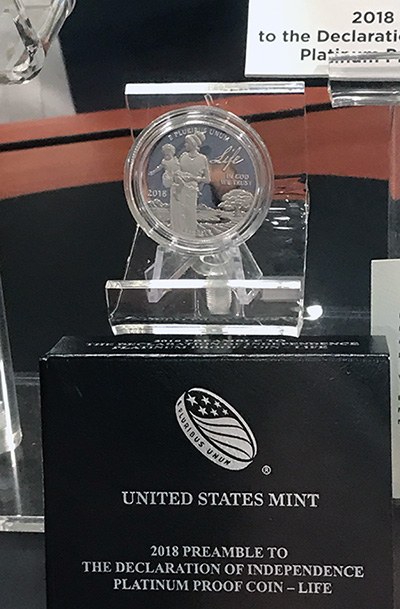
Making its debut at the forum was the 2018 Proof Platinum Eagle. The coin, which was mounted on a rotating display, is the first of a three-coin series commemorating the three principals enumerated in the Preamble of the Declaration of Independence: “Life”, “Liberty”, and the “Pursuit of Happiness”.
The “Preamble” coins are the first in the Platinum Eagle series to feature annual changes to the obverse. Previously, the series would feature John Mercanti’s Liberty on the obverse and intricately detailed allegorical representations of Liberty in various scenes on the reverse.
This new series has a decidedly feminine appearance, although this may not have been the program’s stated intent. Two of the three coins feature Liberty holding a child, and the oversized calligraphic type (derived from Thomas Jefferson’s handwritten document) produces a visual effect that is decidedly new for the U.S. Mint’s numismatic programs.
In terms of swag, the United States Mint offered attendees a “gift bag” filled with pamphlets, cards, and printouts covering the day’s proceedings. In a mylar flip 2″ x 2″ holder, the mint also provided attendees a 2017-P Lincoln cent and a one-cent planchet. We were literally given a “penny” for our thoughts.
The Mint also revealed the existence of three “nonsense” designs struck as trials and prototypes for both the Mint’s 2017 Palladium bullion coin and the 2018 Breast Cancer commemorative gold coin. Images of the three items were provided as part of the Mint’s lengthy powerpoint presentation.
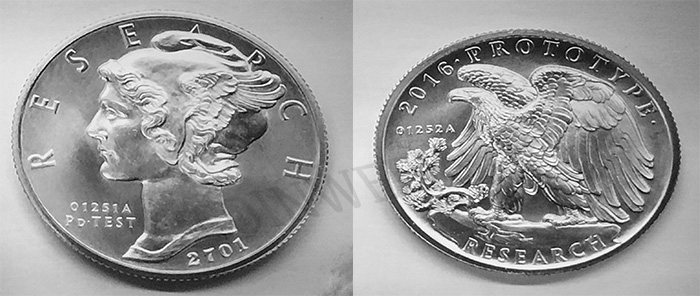
The obverse of the Palladium prototype features Winged Liberty similar to the one seen on the production coin. Wrapping around the top of the rim in large font and spaced lettering is the word “RESEARCH”. In the place of IN GOD WE TRUST was the inscription “01251A PD Test” Under the bust truncation was the nonsense date “2701”.
The reverse featured a version of Weinman’s 1907 AIA gold medal design, which was adapted for use on this coin program. Wrapping around the top of the rim is the inscription “2016·PROTOTYPE·” To the left of the eagle is the test number “01252A”. In the exergue, wrapping around the rim, is the word “RESEARCH”.
The other two were gold “nonsense” designs featuring the familiar pairing of Martha Washington and Mount Vernon, but struck in gold and the Mint’s new “pink gold” formulation. The effigy of Washington was slightly different than those that have appeared before, more portly, with the design continuing to the very bottom edge of the coin. To her left is the inscription “Martha Washington 1759”.
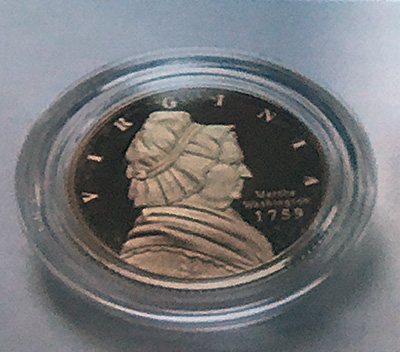 The Mint confirmed that the struck patterns were not destroyed and will be preserved. It’s highly unlikely that examples will ever enter into the numismatic marketplace.
The Mint confirmed that the struck patterns were not destroyed and will be preserved. It’s highly unlikely that examples will ever enter into the numismatic marketplace.
While not shown, the Mint also revealed that it had struck an octagonal prototype of the American gold buffalo design that it had presented it to the Treasury Department. The Treasury rejected the unusual shape out of hand, telling the Mint that “coins are round”. It is unclear whether the Treasury was aware at the time that octagonal designs have played a not-insignificant role in U.S. numismatic history.
Our Takeaway
Articulating objectively what came out of the U.S. Mint forum is an unenviable task. We believe that the Mint, which is under no obligation to put together events such as these, is earnest in its desire to seek industry feedback in order to promote and grow the hobby of coin collecting – at least the hobby of collecting currently offered U.S. Mint products, which, it should be understood by all, is the only area of the market in which the Mint is authorized by law to participate in.
This creates a dichotomy that is often difficult for the industry to reconcile. The U.S. Mint is funded by public, not private, capital. It has a six-million-dollar marketing budget, which sounds small, but it makes aggressive use of this budget to pursue various forms of marketing and achieve total market penetration of its product. Which, given the design, mintage, and subject matter, is either the marquee numismatic product of the year or an unwanted widget that only deserves a second look in the event that collector and dealer apathy for the product provides an opportunity to buy a low-mintage product and immediately re-market it at a high premium.
In other words, the secondary market succeeds when the Mint fails, and when the Mint is too successful the secondary market suffers from a missed opportunity to create arbitrage.
Yet, despite all of the veneer of a capitalist enterprise, the Mint has very strict rules regulating what it can and cannot do within the numismatic industry to foster strategic partnerships that grow the hobby and not just cannibalize the market.
Capital in the rare coin market is much more diffuse, and dealers that make markets in modern coins – either through direct sale, wholesale, or repackaging the products through companies like PCGS and NGC – really are at the mercy of the Mint and its marketing strategies.
At the forum, the Mint announced that it would begin sending push notices via text messages in 2018 to prompt customers to buy Mint products. It is apparent to us that dealers and the Mint are locked in an arms race to gain and keep customers buying what are essentially the same products but offered in different ways.
If the Mint had a true wholesale program, it would allow more dealers to make markets and sell products to customers and even spur a return of brick-and-mortar coin businesses, which again adds retail acreage and grows interest and demand in all coins, not just recent issues.
Some of the dealers we spoke to off the record lamented that the kind of synergy that would really be helpful just doesn’t seem possible – this despite the fact that the Mint’s own reporting pegs bulk purchases for numismatic products at 22 percent. An asterisk is necessary for this figure as many numismatic products are purchased by bulk customers through retail channels. A more accurate number (according to two industry sources that we talked to) pegs the true wholesale share of total numismatic sales at between 35% and 40%.
Yet despite this apparent strength and buying power on the part of bulk buyers, the Mint, under a mandate to treat everyone equally and show no favoritism, is only able to work the margins.
Collectors have a real stake in this relationship as well and should be in favor of a fostering a better relationship between coin dealers and the Mint, one that promotes a spirit of innovation and improvements of the Mint’s product line while opening up the opportunity for a viable secondary market to exist. And not just for new releases in the “launch bubble” but for recent-year releases as well.
2018 and 2019 offer collectors and dealers myriad opportunities to buy great products from the Mint. The World War I and Apollo 11 programs are among the most exciting numismatic issues that the Mint has released in the past several years.
The Mint’s silver medal tie-in with the World War I coin and the 1/10 ounce 225th Anniversary gold coin release show a Mint that is willing to use flexibilities “built into” existing bullion coin legislation to create and market a new class of numismatic products – but how much better would these programs be if they were worked out in consultation with the leading creative minds in the numismatic industry. These voices would have told the Mint up front that it needed to offer collectors a seven-piece option, where they could buy an uncirculated and Proof example of the World War I dollar and each of the silver military service medals.
This approach would also be helpful in instructing the Mint how the release of certain gold or silver medal “tributes” to vintage or rare coins could directly spur interest in these areas of the traditional rare coin market. A series of gold bullion pattern coins revisiting unused designs of the 19th century could spur interest in patterns. An Ultra High Relief Saint Gaudens $10 would be a smash hit! This is the type of information industry leaders can share with the Mint that would go a long way to creating real excitement and synergy.
For the time being, there continues to be an incentive on the part of dealers to do volume business with the Mint, to try to create markets for their coins that might not otherwise exist without “value-added” features, such as coin certification and special label programs. The margins for this type of business get tighter and tighter with each passing year. And so, the uneasy dance between the Mint and its largest customers continues.
Wouldn’t it be better if the stakeholders had real opportunities to work together to grow sustainable and innovative coin markets? We think so.





Great story. Did not see this covered anywhere else yet.
The WWI coin and medal rollout is going to blow up in their face. How can they not see that they are going to p.o. everyone that cannot get all five medals at issue price. AND we have to buy five commems to get the medals. Offering the five sets with one click is out only chance to get the full set before sellout.